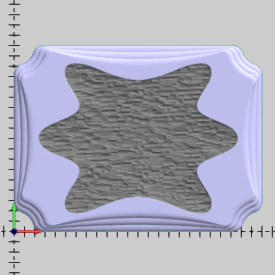
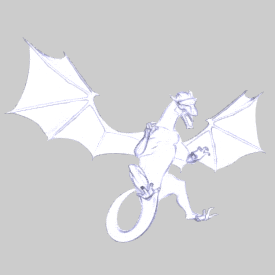
This help topic explains how to create an Emboss from Component feature using BobART. In this example, you work with an existing part which is an artistic sign. The base of the sign, including a texture, is complete. Multiple Emboss from Component features are added to the model using the same component for each feature. The component features added in this tutorial are used to complete the design of the part.
The BobCAD part file for this tutorial is available for download at: http://www.bobcad.com/helpfiles. If you are connected to the Internet, you can click the link provided to download and save the Emboss from Component Example 1.bbcd zip file. After downloading the zip file, extract the files on your system in a place that is easy to remember. You can then open the BobCAD file (.bbcd) to use with this tutorial.
In the example file provided, a few emboss features are already created to make an artistic sign as shown in the following image. The component (.stl file) used in this tutorial is shown in the second image.


1 In the File menu, click Open.
2 In the Open dialog box, navigate to the location in which you saved the example file.
3 Select Emboss from Component Example 1.bbcd, and click Open.
4 In
the Data-CAM Tree Manager, click
the ![]() BobART
tab.
BobART
tab.
5 Next
to ![]() Emboss Model,
click
Emboss Model,
click  to expand the tree.
to expand the tree.
You see the four previously defined Emboss features in the tree.
The component used in this tutorial can be downloaded using the Example Files link at the beginning of this help topic. If you have already downloaded the example files and you have completed the Emboss from Image example, you can use the component that you created in that tutorial.
1 In
the BobART tree, right-click ![]() Emboss Model,
and click Emboss from Component.
Emboss Model,
and click Emboss from Component.
2 In the Open dialog box, navigate to and select the folder in which you have saved the component.
Select Dragon Component.stl, and click Open.
3 The Create Emboss from Component dialog box is displayed with a preview of the selected component.
The preview shows the defined stock and any existing emboss features that are currently displayed in the Workspace.
Notice that the component is automatically placed with the origin (lower-left corner) of the component at X0Y0Z0.
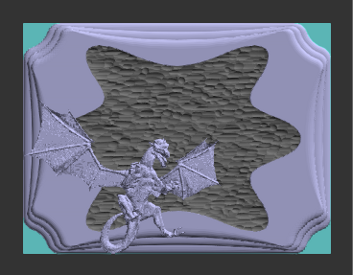
4 Before defining the feature parameters, click OK to close the dialog box.
(Normally you define the parameters first, but for this example, this is done to show you what to expect when editing the feature.)
5 In
the ![]() BobART
tree, right-click
BobART
tree, right-click ![]() Emboss Model, and click Regenerate.
Emboss Model, and click Regenerate.
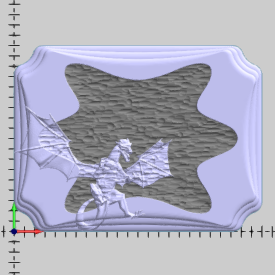
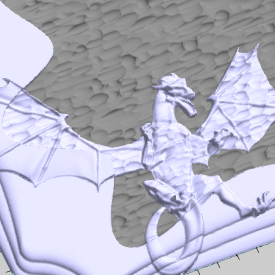
6 To edit an emboss feature, you use the Emboss Feature in the BobART Tree.
In the BobART
tree, right-click ![]() Emboss
from Component 5, and click Edit.
Emboss
from Component 5, and click Edit.
When the Emboss from Component dialog box is open, it displays the current condition of the embossed model with the component that you are editing. The defined stock is shown in the preview even if you have the Remove Non-Emboss Area check box selected in the Stock Parameters dialog box (which is the case in this tutorial).
Notice that the preview shows the current location of the component. To make it easier to modify the current Emboss from Component feature, you change the color of the feature.
1 In the Emboss Attributes group, click Color.
In the Color dialog box, select a green color, and click OK. The preview is updated in the Create Emboss from Component dialog box.
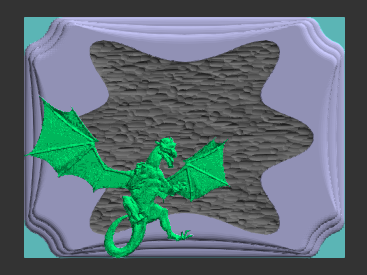
2 To update the size of the component to better fit the model, in the Model Size group, change the X Size value to 12.00 and press Tab.
Notice that the Y Size and the Z Height values are
automatically updated because the  Keep Same Ratio check box is selected.
Keep Same Ratio check box is selected.
The preview of the component is updated. (The preview continues to show the current appearance of the component, and it also shows any modifications of the component being edited.)
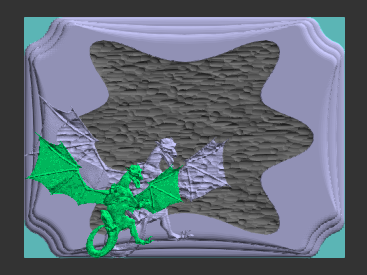
3 In the Origin group, set the X value to 5.00, and set the Y value to 5.00.
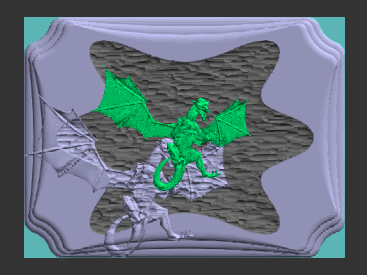
You can see that the component still needs to be adjusted some to be centered in the textured area.
4 In the Origin group, next to X, click the up arrow until the model appears in the proper location (in X). (The final value for this example is X5.75.)
5 Repeat this process for the Y value of the component. Click the arrows until the component appears in the desired location. (For this example, the final value is Y4.85.)
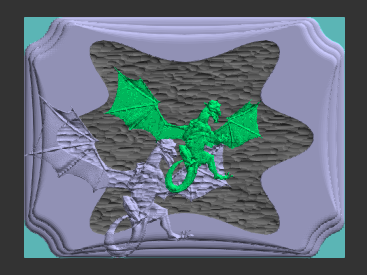
6 Click Color. Select the desired color for the feature, and click OK to close the dialog box.
7 To close the dialog box, click OK.
Right-click Emboss Model, and click Regenerate.
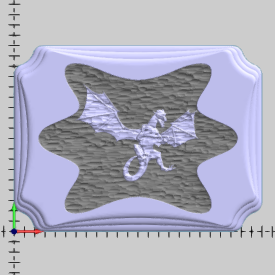
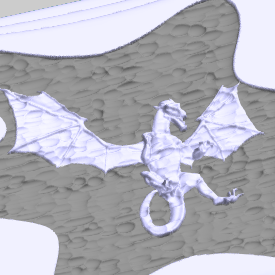
Notice that the texture is being applied to the component. This is a result of the application type, Add, and the location of the feature. (The component is being added to the Emboss Texture feature.)
1 Right-click
![]() Emboss from Component
5, and click Edit.
Emboss from Component
5, and click Edit.
2 In the Origin group, set the Z value to 0.550.
This setting is used to move the component up (in the positive Z-axis direction) so that the Merge High application type can be used.
3 In the Application Type group, click the arrow, and click Merge High.
This eliminates the texture from appearing in the component feature because only the highest portion of the model is kept.
4 To close the dialog box, click OK.
5 To update the changes in the model, Regenerate.
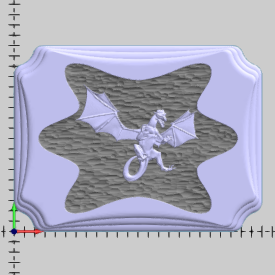
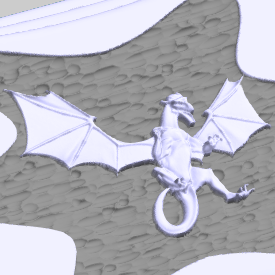
When creating Emboss from Component features, you can add as many features as you need using the same component. This means that you don't need to have multiple copies of the same component in order to create multiple features from the same component.
1 Right-click Emboss Model, and click Emboss from Component.
2 In the Open dialog box, select Dragon Component.stl, and click Open.
3 In the Model Size group, change the X Size value to 4.00 and press Tab.
4 Under Orientation, in the Rotation group, set the Z value to 45.00. (This rotates the component around the Z-axis.)
5 Confirm that the Application Type is set to Add.
6 In the Origin group, set the X value to 1.250, and set the Y value to 3.400.
TIP: When placing components in the Emboss from Component dialog box, the origin is found by creating a bounding box around the component. The lower-left corner of the bounding box is the origin (as shown in the following image). When you rotate components in the Emboss from Component dialog box, the origin is automatically updated to remain at the lower-left corner of the component's bounding box (as shown in the second image).
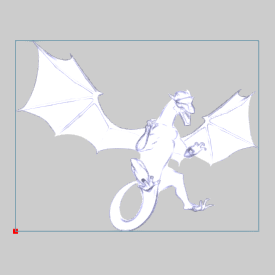
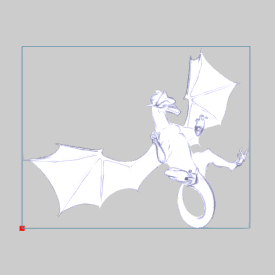
7 To accept the parameters and close the dialog box, click OK.
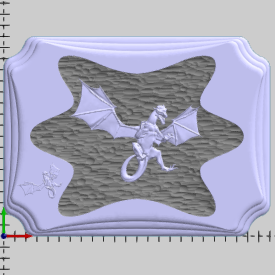
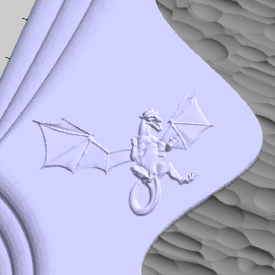
1 Right-click Emboss Model, and click Emboss from Component.
2 In the Open dialog box, double-click to select and open Dragon Component.stl.
3 In the Model Size group, change the X Size value to 4.00.
4 Under Orientation, in the Rotation group, set the Z value to -45.00.
5 In
the Mirror group, select the  Y-Z Plane check
box.
Y-Z Plane check
box.
6 In the Origin group, set the X value to 18.700, and set the Y value to 3.400.
7 To close the dialog box, click OK.
Regenerate to update the model.
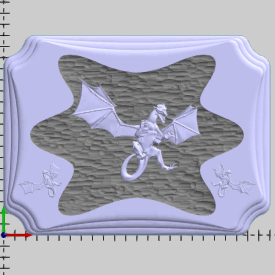
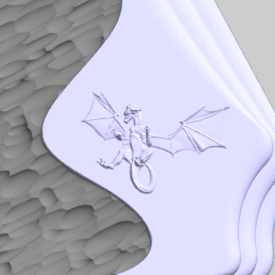
You can continue to add components to create mirrored patterns as shown next.
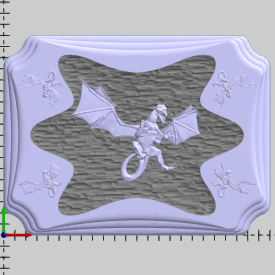
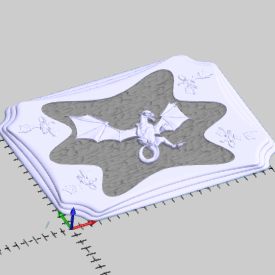
In the next few parts of the tutorial, you add the final two components as shown in the previous images. This time rotation is also applied in the X- and Y-axes to make the dragon protrude from the sign.
1 Right-click Emboss Model, and click Emboss from Component.
2 In the Open dialog box, select Dragon Component.stl, and click Open.
3 In the Emboss from Component dialog box, make the following settings.
In the Model Size group, change the X Size value to 4.00.
In the Rotation group, set the X value to 12.250.
In the Origin group, set the X value to 1.250, and set the Y value to 11.600.
Click OK, and Regenerate the model.
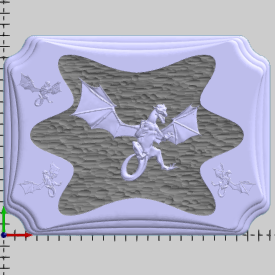
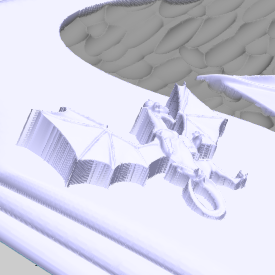
4 Right-click Emboss from Component 8, and click Edit.
5 In the Rotation group, change the X value to 0.00.
In the Y box, type 12.250.
Click OK, and Regenerate the model.
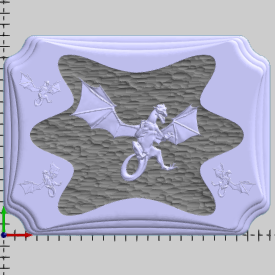
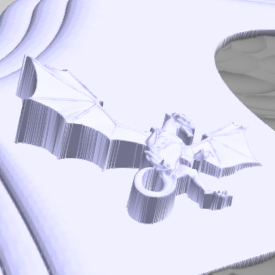
6 Edit the feature (as in Step 4), and change the following parameters.
In the Rotation group, change the X value to 12.250.
In the Z box, type 45.00.
Click OK, and Regenerate the model.
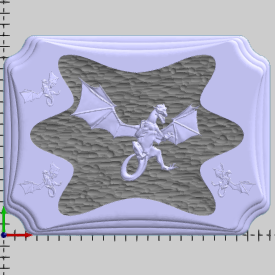
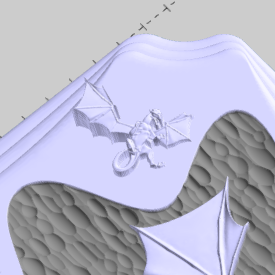
1 Right-click Emboss Model, and click Emboss from Component.
2 In the Open dialog box, double-click to select and open Dragon Component.stl.
3 In the Model Size group, change the X Size value to 4.00.
4 In the Rotation group, set the X value to 12.250, and set the Y value to -12.250.
Set the Z value to -45.00.
5 In
the Mirror group, select the  Y-Z Plane check
box.
Y-Z Plane check
box.
6 In the Origin group, set the X value to 18.700, and set the Y value to 11.600.
7 Click OK, and then Regenerate to update the model.
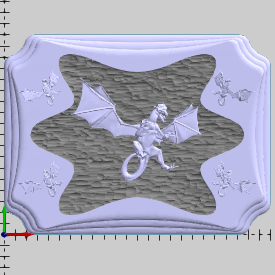
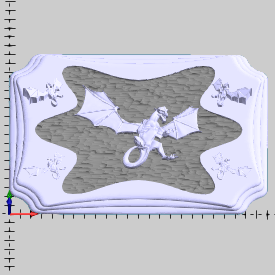
This concludes the tutorial.